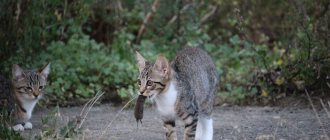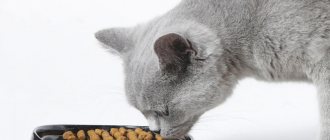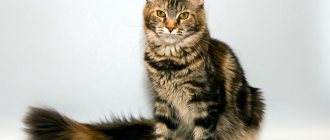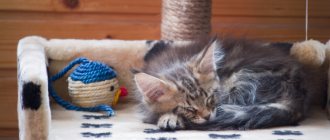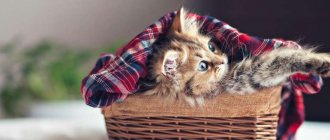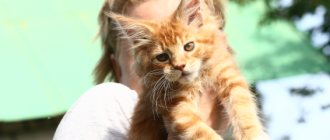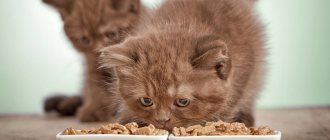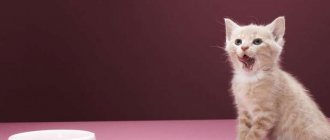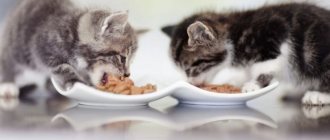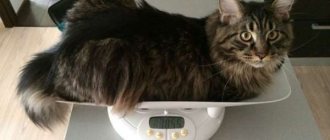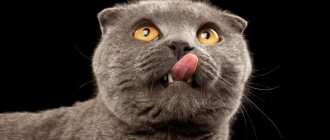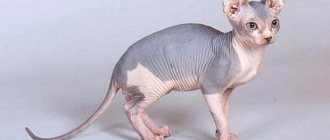Breed Features
Maine Coon translated as “Maine raccoon” (Maine, USA). The weight of an average male is from 6 to 8 kg, females - 3.5-5 kg. Often individual specimens reach 12 or even 15 kg.
These animals are not only the largest among felines, they:
- energetic;
- mobile;
- excellent hunters;
- have a huge fluffy tail and tassels on the ears, a strong skeleton and muscle corset, a wide skull;
- have semi-long hair.
All these features are reflected in feeding. To maintain life potential and health indicators (energy, fur quality), you need not just cat food, but a high-quality diet. Often when taking such a kitten into your home, problems arise. Reviews indicate that animals constantly ask for food. They scream angrily and demand food.
Looking at the characteristics of the breed when preparing the diet, you should make sure that it is:
- balanced;
- with optimal protein content;
- without a predominance of carbohydrates (does not contain grain base, soy and cereals);
- with easily digestible fats (as a source of fat-soluble vitamins);
- rich in mineral components.
Unbalanced and low energy value contributes to overeating, which should not be allowed.
Standards
They are determined by the felinological system adopted in the country. Popular: WCF, TICA, FIFe. In the Russian Federation, WCF is more often used.
| WCF | TICA | FIFe | |
| Body |
| large long body, rectangular in shape |
|
| paws of medium length |
|
| |
| the tail has long hair, its length reaches the shoulder | tail well furred | tail with flowing hair, long | |
| Head | massive skull | the forehead is rounded quite strongly | the forehead is softly rounded |
| high cheekbones | prominent cheekbones | ||
| massive box, square shape | box - square | muzzle - square | |
| massive chin | straight chin | strong chin | |
| the neck is of medium length | muscular neck | neck is strong | |
| Ears |
|
|
|
| Eyes |
|
|
|
| Wool |
|
|
|
| Color |
| any colors |
|
| Defects | coat of one length |
|
|
Choosing a place and dishes
Even if the owner is ready to share his plate with his pet, he must have a place and separate dishes.
The place where food is taken should be:
- secluded. An animal receiving food cannot be in the middle of the room; it cannot be stepped over, walked around, or moved away. If you carefully monitor its habits, you will notice that having taken a piece of meat, the cat pulls it under the table, under a chair, into the far corner. This is normal for a cat, and you cannot change its nature at your discretion;
- easy to clean. Cats do not always eat from a bowl carefully. Often the four-legged animal pulls out food and eats near the bowl, thereby dirtying the floor. The soiled area should be washed immediately;
- accessible. There is no point in equipping bowls in a cabinet or drawer. The animal must always have access to a bowl of water. And approaching and sniffing the food bowl, even an empty one, will tell the owner that the cat is hungry without meowing.
Cat dishes should be heavy. It is better to choose from thick glass or stainless steel.
The bowl should not:
- move;
- roll over;
- jump up in every possible way.
Bowls for food and water can be the same and located next to each other. The water should be changed daily and the bowls should be washed.
What to feed a Maine Coon kitten
When choosing a feeding diet, you need to think about:
- The benefits of food for the animal's body;
- Your pet’s taste preferences;
- Practicality and convenience for the owner.
Buying animal feed is not at all difficult. There is no longer any need to visit specialized stores; just look into the feed department of an ordinary supermarket or small store. This is of course convenient and such food (dry or canned) should be present, even if the animal is fed a natural diet (just in case).
Natural diet
In nature, carnivores are hunters and eat meat. It is completely in vain for a person to try to switch pets to carbohydrate foods, thereby harming them and creating problems for themselves.
The Maine Coon's diet should consist of:
- meat and meat products;
- fish (sea);
- eggs;
- dairy products.
Meat and meat products
Fresh, not frozen meat products are most preferable. In this case, it is better to alternate beef with pork, chicken with rabbit. By-products are quite appropriate:
- heart;
- lungs;
- kidneys;
- chicken gizzards;
- liver (except beef).
When preparing, it should be taken into account that if the meat can be given raw, then the offal must be boiled for at least 15 minutes.
Veterinary and sanitary examination cannot deny salmonella (a pathogenic microorganism), and the place of its localization is offal, which is why they should be boiled.
Cats happily feast on the epiphyseal parts of chicken and turkey tubular bones (the ends of a long tubular bone). Bone and cartilage tissue are irreplaceable sources of phosphorus, calcium and other minerals. There is no point in depriving your pet of such pleasure, especially since he can handle it.
Meat and offal should account for at least 70% of the diet every day.
Dairy products
If a cat happily drinks raw milk, good for his health. If not, then you should offer yogurt or kefir.
Fermented milk cheese (cottage cheese) and sour cream are also an excellent source of proteins and fats of animal origin.
For the normal functioning of the intestines, a constant replenishment of lactic acid bacteria is necessary, which normalize the digestion processes of the quadruped. Fermented milk products will help the animal with this. In addition, they are a source of:
- minerals;
- unsaturated and saturated fatty acids;
- fat-soluble vitamins (A, D, E, K);
- essential amino acids.
Important! Products labeled “milk containing product” or “cheese product” should not be used as food. Such products contain albumin - an artificial protein; the body does not need it.
Eggs
This component of the diet is very important, especially for a growing organism. Vitamin U found in raw yolk (it is destroyed during heat treatment) is indispensable for the animal, especially if the owner voluntarily decided not to give the cat raw meat and fish.
Before feeding eggs, you need to check for allergenicity. If everything is fine after eating, you can safely include it in your diet.
Fish
Sea fish is rich in:
- protein;
- calcium;
- phosphorus;
- micro and macroelements;
- fats saturated with Omega-3 acids.
By introducing fish into the diet, there is no need to put the animal on vitamin supplements from a bottle.
Particular attention should be paid to fish from inland waters. Such fish should not be fed raw.
Important! Fish is served either boiled or not included in the diet at all.
Cereals, vegetables and fruits
There are times when a cat happily visits cucumber plantations in the country and spoils the harvest. Perhaps the cat will lick a banana or chew beets, but these are his gastronomic preferences, and nothing more. There is no need to feed your cat potatoes and oatmeal.
Carbohydrates disrupt the acidity of a carnivore, provoking the microflora from opportunistic to become pathogenic.
The benefits of a natural diet
Expert opinions are increasingly moving towards natural feeding
- If an allergy is provoked, food can be quickly excluded from consumption;
- the quality of the feed is easily controlled by the owner;
- You can independently choose a high-quality product without additives.
Flaws
Among the disadvantages of such feeding is the labor intensity, consisting of:
- procurement (selection, purchase, transportation);
- preparation (boiling, grinding, cooling);
- safety and monitoring of the expiration dates of perishable products.
Ready-made feed
It’s very easy to pour dry granules into your pet’s bowl. In addition, in order to attract attention, the manufacturer, when labeling, indicated how many nutrients, vitamins and minerals that even an educated person would believe.
In fact (and laboratory studies confirm) the food does not contain even half of the declared ingredients. Moreover, even expensive foods suffer from unprofessional composition and sometimes falsification.
Even if the feed contains the stated vitamins and amino acids, they are synthetic and their digestibility is several times lower than that of a natural product. The preparation of such feeds is carried out at high temperatures, and many vitamins are not heat stable.
When giving preference to this food, purchase only:
- Packaged in an individual package;
- Labeled (manufacturer, address, telephone);
- Indicating who it is intended for;
- With date of manufacture and expiration date.
Advantages
The main advantage of this food is its ease of use. I poured it in and forgot. But, after all, caring for an animal, preparing food for it, watching it eat, we get great pleasure. Consequently, even this advantage turns into a disadvantage.
If the cat eats the prepared food and feels well, then you can continue feeding it. If there is the slightest problem with mucous membranes, hair, or skin, it is better to refuse food.
Disadvantages of ready-made food
The disadvantages are the following:
- you cannot control the composition (you have to take my word for it);
- uncertainty about the balance of components;
- Contained preservatives and emulsifiers, other additives, can cause pathology.
Mixed diet
Many owners prefer a mixed type of feeding. It's comfortable. Ready-made food can be kept “just in case,” and natural feeding can be used as a basis.
You can feed or supplement your pet with ready-made food if he wants to eat it.
You can also use dry food while traveling, where it is not possible to prepare food.
Leonardo Quality Selection
Photo: https://beru.ru
The best premium food with natural ingredients. The basis of the diet is chicken meat and hearts, supplemented with zinc, phosphorus, manganese, vitamins E, D, A and B. The composition contains no preservatives or artificial flavors. And one jar is enough for even a large Maine Coon to last a whole day. A balanced diet is perfectly absorbed by the pet’s body and has a positive effect on its appearance.
Leonardo Quality Selection cat food
Advantages:
- reasonable price
- well digested
- efficiency
- versatility
- absence of harmful components
- a lot of meat in the composition
- pleasant aroma
Sample menu by age
Up to a month
The main food during this period is mother's milk. If the kitten begins to independently search for food, complementary feeding should be started. Provided that milk substitutes are needed up to 20 days of age.
Starting from the age of 20-25 days, you can feed minced meat prepared from boiled meat or fish, and fermented milk products. Feeds should be alternated, starting with very small doses:
- minced meat (fish and meat) - 10-15 g;
- eggs - 1/6 part (10 g);
- cottage cheese - 10 g.
Advice! Observe and monitor the body’s reaction (diarrhea, constipation) to the introduced new products.
The serving size is calculated virtually. The kitten will not overeat, but tomorrow it will eat 10-15 g more. Food should be offered frequently. Up to a month, the stomach is small, but the growth rate is high.
The feeding frequency can be as follows:
- 1-10 days they feed every 2-2.5 hours (so he suckles his mother);
- 10-20 days - interval 2.5-3 hours;
- 20-30 days - interval 3-3.5 hours.
It should be noted that everything is very individual and depends on the energy component of the feed.
1 month
At this age, the diet needs to be more varied. You can offer your cat all of the products listed above. A taste preference is established and it is advisable to follow it.
The multiplicity decreases, and the rate increases. During this period, the kitten can already hide food. This will indicate surplus.
We can offer:
- minced meat and fish 15-20 g per appointment;
- curdled milk - 50 g;
- 1/3 egg.
Dry food can be soaked with water or milk in 10-15 g at a time. Canned food should be selected in a small package of 20 g and, after opening it, feed it to the animal.
2 months
You can avoid raw milk by switching to fermented milk products. The diet must contain at least 4 different ingredients. The frequency of feeding is up to 5 times a day.
In a day, a kitten can easily master:
- meat products - 30-40 g;
- sour milk or curdled milk - 40-50 g;
- ½ egg;
- sour cream - 1 tbsp. spoon.
The amount of dry food, depending on its nutritional value, can vary from 15 to 30 g. Canned meat is offered in the amount of 20 to 50 g.
3 months
From this age, the norm increases, and the multiplicity decreases up to 4 times. At this age, the peculiarity of Maine Coons manifests itself: some tend to beg for food, others indifferently pass by the bowl, but everything is very individual.
In the diet, you can reduce the amount of meat and add offal about 50 g per day, as well as:
- fermented milk - 50-60 g;
- egg - 1 pc.;
- boiled fish - 30-40 g.
If the cat is very active, add 2-3 tbsp sour cream to the diet. spoons. If you feed dry food, then at this age the cat can handle 100 g, but depending on the quality of the food.
When selecting canned food, give it to the packaging for 100 g. Feed it in parts, opening it in the morning, the rest can be put aside until lunch by storing it in the refrigerator.
4 – 6 months
A time of intense weight gain. The more balanced and nutritious the food, the less the cat will eat. The multiplicity remains up to 4.
All products from the listed list should be present in the daily diet. 50-60 g of meat, fish and sour cream will not be much at all.
If the weight is rapidly gaining, but the cat requires food, add fatty varieties of cottage cheese and meat.
Dry food is given in a dose of 120-150 g, canned food 100-120 g at a time.
From 6 months to 1 year
You can transfer the animal to 3 feedings a day. In nature, cats can feed only once a day (at the time of a successful hunt). At home they do not have such a need.
The phase of growth and formation of the skeleton and muscle mass continues. The diet should be complete, balanced, nutritious. If the cat asks to eat, you need to add calories through fatty meats and fish, sour cream and cottage cheese with a higher fat content. Kittens are quite energetic and their growing bodies are not afraid of obesity.
At this age he will eat:
- meat products and offal - 60-70 g;
- fermented milk - 70-80;
- minced fish - up to 50 g.
The norm of dry highly nutritious food is up to 150 g, canned meat is up to 160 g.
Feeding schedule
Diet, food quality, frequency and number of feedings per day are important for your pet’s health. Depending on the age of the maines and their physiological state, the feeding regime changes flexibly. The opinion that Maine Coons need to be fed according to their requirements is erroneous; animals do not always feel moderation in food, which leads to overeating and obesity, disturbances in the functioning of the heart, shortness of breath and constipation. A strict feeding schedule and dosed distribution of feed will help to avoid negative consequences.
Table: Mae-coon feeding schedule depending on age and physiological state:
The appearance of the Maine Coon, the condition of its shiny, well-groomed coat, the activity of its behavior, and its friendly character indicate the correct maintenance and chosen balanced feeding regime for the pet.
Vitamins and supplements
Indicators of a cat's health are:
- coat;
- leather;
- condition of mucous membranes;
- energy;
- lack of rapid fatigue;
- absence of frequent disorders of the gastrointestinal tract.
If these indicators are normal, the animal does not need synthetic vitamins.
Vitamin and mineral supplements are medications. They are prescribed by a doctor based on the results of clinical and laboratory tests.
Veterinarian recommendations
To normalize digestion and maintain your pet’s health, it is recommended to follow the following recommendations:
- Use stainless steel bowls. Plastic releases toxins into food.
- Watch your drinking regime. The cat should receive 20–40 ml per 1 kg of weight for the normal functioning of the gastrointestinal tract and urinary system.
- Feed on a schedule. Cats get used to a certain regime. It is easier for their body to digest food if they follow a schedule.
- Watch your physique. Manufacturers' recommendations are a guideline, but not exact data. If the general norm is observed, animals with different metabolisms and activities can lose or gain weight.
What not to feed a Maine Coon kitten
The owner does not always adequately respond to the pet’s “requests”. For example, some cats really love potato chips. However, it is not animal food (or human food).
The following products are not acceptable as feed:
- smoked meats;
- raw fish (especially freshwater);
- sausages;
- fatty meats and fish;
- sauces such as mayonnaise;
- fried foods (cutlets, steaks);
- flour and pasta products.
Taking into account the characteristics of the breed and the basics of rational feeding, you can raise a healthy and energetic Maine Coon.
Nutrition for illnesses
Maine Coons have amazing energy, stamina and excellent health, but these strong cats also have health problems. The main “sores” are hereditary in nature, so it is important to carry out breeding work very carefully - to prevent cats with poor heredity from breeding.
Main health problems:
- hypertrophic cardiomyopathy. The disease can cause sudden death in a kitten or older animal. It is important to have veterinary heart testing and reduce salt intake;
- urolithiasis disease. To prevent the disease, it is necessary to: exclude fish, not use economy-class food, and ensure adequate drinking conditions. For preventive and therapeutic purposes, it is useful to use food from the Urinari veterinary line: Royal Canin Urinary S/O, Purina Pro Plan Urinary, Eukanuba Veterinary Diets Urinary Oxalate.
- joint diseases. To prevent this type of disease, it is important to feed only high-quality feed that contains chondroitin sulfate and glucosamine, which are responsible for the structure and health of joints. If joint disease occurs, as well as obesity, which increases the load on the joints, the animal should be switched to special veterinary food: Eukanuba Veterinary Diets Urinary Struvite for Cats Dry, Hill's Feline j/d.
Let's watch a video about Maine Coon nutrition
